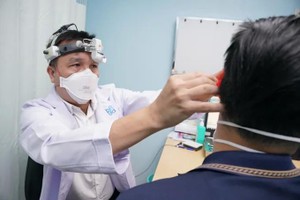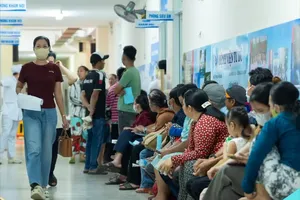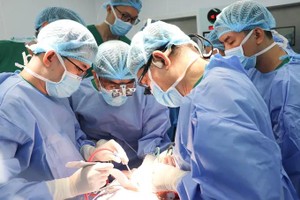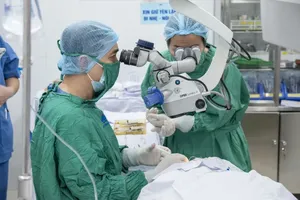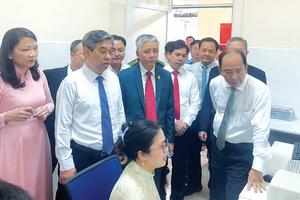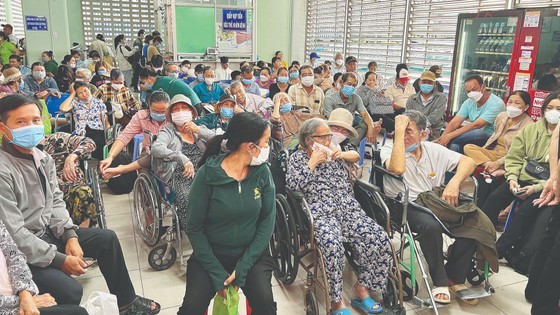 |
Patients are waiting for diagnosis and treatment in Cho Ray Hospital of HCMC on July 24 (Photo: SGGP) |
Owning a medical insurance, 38-year-old Le Thi H from Cau Giay District of Hanoi still opts for private hospitals or the service sector of public hospitals. What concerns her is the inconsistent medical fees among public hospitals at different levels.
For instance, the highest fee for disease diagnosis in Bach Mai Hospital in Hanoi is VND150,000 per turn (US$6.34) if treated by a professor. The most expensive one in Hanoi Medical University Hospital is double regardless of doctors. In HCMC, the highest fee is VND500,000 ($21.1) per turn while the costliest one in HCMC Oncology Hospital is VND200,000 ($8.45).
Statistics from the Department of Planning and Finance under the Health Ministry reveal that the proportion of patients choosing the service sector of central-level and provincial-level public hospitals is under 10 percent. This figure is zero in rural-district-level hospitals.
The introduction of Circular No.13 is to unify medical fees in the service sector of public hospitals and to guarantee consistent service quality and medical treatment conditions in correlation with the paid money. This does not affect disease diagnosis and treatment using health insurance.
Deputy Prime Minister Tran Hong Ha stressed that this new regulation on medical fee calculation gives way for state-owned hospitals to become financially autonomous, increase their service quality, and have sufficient resources to retain high-level human resources. This regulation also adds extra revenues to invest in healthcare in remote areas of the country.
Dr. Diep Bao Tuan, Director of HCMC Oncology Hospital, commented that Circular No.13 is the first to give detailed legal instructions on disease diagnosis and treatment in the service sector of public hospitals. It is a legal basis for these medical institutes to precisely calculate service fees. However, state-owned hospitals are allowed to adjust these charges to satisfy both the hospital and patients.
Dr. Dao Xuan Co, Director of Bach Mai Hospital, praised the openness of this Circular, saying that it does not give one fixed service rating but provides a fee range from the minimum to maximum so that each hospital can adapt to its own needs and current medical facilities. In addition, the Circular allows state-owned hospitals to partner with foreign counterparts or foreign experts to improve service quality and better serve patients.
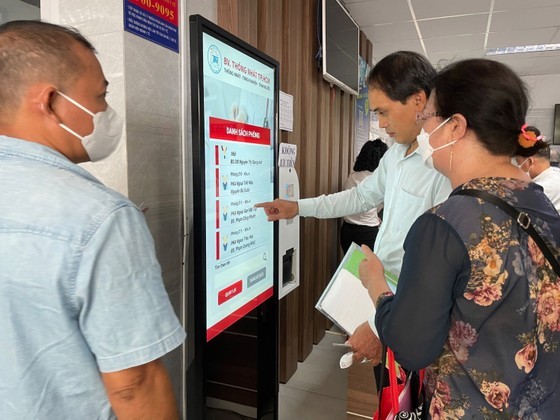 |
Patients registering for disease diagnosis and treatment in Thong Nhat Hospital in HCMC (Photo: SGGP) |
At the same time as introducing Circular No.13, the Health Ministry is developing the economic-technical norms for nearly 10,000 technical medical services for the sake of correct and sufficient calculation. This list will be released and come into effect among public hospitals when the Disease Diagnosis and Treatment Law (amended) is applicable on January 1, 2024.
To explain this new calculation method, Deputy Minister of Health Tran Van Thuan said that the current method only considers four out of seven aspects, namely medicine and medical supplies, electricity and water use, medical equipment maintenance, and staff salary. The other three are covered by patients, consisting of major repair of fixed assets, asset depreciation, training cost and scientific research.
Until 2018, the Health Ministry announced a list of 18,000 techniques for disease diagnosis and treatment to be the foundation for the current economic-technical norms as well as prices of technical medical services. There is still overlapping in these services that need rearrangement for a more precise calculation in order to reduce the cost patients have to pay, and thus ensuring the rights of both the hospital and its patients.
The estimated increase in medical fees in the upcoming time is inevitable when the national monthly base salary rises. More importantly, this fee growth must be parallel with better medical service provision and a more professional attitude of the medical staff when communicating with patients.
What is also worth mentioning is the outdated fee frame for disease diagnosis and treatment using health insurance. With such a shortage in revenues compared to the essential spendings, public hospitals find it a tough challenge to develop professionally. Obviously, precise calculation of medical fees is a must for state-owned hospitals to decrease their dependence on the state budget and have more conditions to develop to the fullest.
The Health Ministry has just proposed hospital fee adjustments based on the rise of the national monthly base salary. Accordingly, the increase of disease diagnosis and treatment fees will be 5 percent, and the health insurance fund expenditure will grow by VND2.7 trillion ($114 million) a year. This proposal can be applied from this July.
If also counting the management cost, the fees will see an extra growth of 4 percent while the health insurance fund expenditure will rise by VND2.18 trillion ($92 million) a year.
The Health Ministry will review the asset depreciation for hospitals at each level and specialty to suggest a feasible route to add this sum into the fees for disease diagnosis and treatment, taking into consideration the ability to balance the health insurance fund, patients’ ability to pay medical fees, and the current socio-economic status. This proposal, when approved, is planned to come into effect at the end of 2025.

